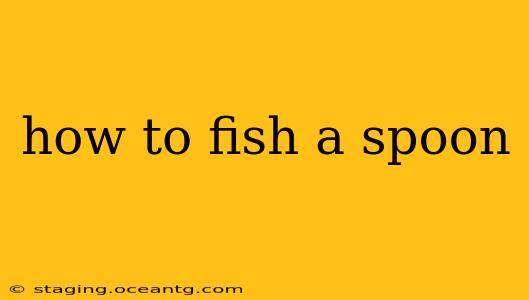Spoon lures are a staple in any angler's tackle box, known for their versatility and effectiveness in catching a wide variety of fish species. Their shimmering, reflective surfaces mimic the flash of baitfish, triggering aggressive strikes from predatory fish. But mastering the art of fishing a spoon requires understanding its nuances. This comprehensive guide will cover everything you need to know, from choosing the right spoon to mastering its retrieve.
What is a Spoon Lure?
A spoon lure is an artificial fishing lure shaped like a spoon, usually made of metal (though some are plastic). The curved shape and weight allow for casting distance and an enticing wobble or flash in the water. Their simple design belies their effectiveness; spoons can be fished in a variety of ways, making them adaptable to different fishing conditions and target species.
Choosing the Right Spoon
The selection of your spoon will significantly impact your success. Consider these factors:
- Size: Smaller spoons are ideal for smaller fish like trout or panfish, while larger spoons can attract larger predators like bass or pike.
- Weight: Heavier spoons cast further and sink faster, suitable for deeper water or faster currents. Lighter spoons are better for shallower water or slower retrieves.
- Material: Different metals (brass, copper, nickel) produce varying levels of flash and vibration. Experiment to see what works best for your target species.
- Color: Color selection depends on water clarity and fish preference. Bright colors work well in murky water, while more subtle colors are better in clear water.
How to Rig a Spoon Lure
Spoon lures are generally easy to rig. Simply tie them directly to your fishing line using a suitable knot, such as a Palomar knot or improved clinch knot. These knots are strong and secure, minimizing the chance of your lure coming untied during a fight. It's a simple process, but crucial for success!
Techniques for Fishing a Spoon
The retrieve is crucial for success when fishing with spoon lures. Here are a few popular techniques:
- Steady Retrieve: A consistent, steady retrieve is a great starting point. This creates a natural, swimming action that mimics fleeing baitfish.
- Stop-and-Go: This technique involves reeling in steadily for a few seconds, then pausing for a second or two before resuming the retrieve. The sudden stop often triggers a reaction bite.
- Jigging: Jigging involves raising and lowering the spoon vertically, allowing it to flutter and flash in the water. This technique is especially effective in deeper water or around structure.
- Trolling: Trolling is a method where you drag the spoon behind your boat at a controlled speed. This technique is effective for covering large areas of water and is often used when targeting pelagic species.
What type of fish can you catch with a spoon?
Spoon lures are incredibly versatile. You can catch a wide variety of fish species using spoons, including trout, bass, walleye, pike, salmon, and panfish. The key is to choose the right size, weight, and color of spoon for the target species and water conditions.
What is the best retrieve for spoon fishing?
There's no single "best" retrieve. The ideal retrieve depends on the specific situation, including the target species, water conditions, and depth. Experimenting with different retrieves – steady, stop-and-go, jigging, or trolling – is key to finding what works best. Observe the action of your lure; adjust your retrieve accordingly to create the most enticing movement in the water.
What kind of rod and reel should I use for spoon fishing?
The best rod and reel for spoon fishing depend on the size and weight of the spoon you're using, as well as the size of the fish you're targeting. Generally, a medium-light to medium power spinning rod paired with a spinning reel is suitable for most spoon fishing applications. For larger spoons or bigger fish, a medium-heavy rod might be necessary.
How do you fish a spoon in deep water?
Fishing spoons in deep water often requires using heavier spoons to achieve sufficient depth. Jigging is a particularly effective technique in deep water, as it allows you to work the lure through the water column and attract fish from various depths. Consider using a depth finder to identify the location of fish and adjust your technique accordingly.
How deep do spoon lures go?
The depth a spoon lure reaches depends on its weight, the retrieve speed, and the type of retrieve. Lighter spoons will stay shallower, while heavier spoons sink deeper. A faster retrieve keeps the lure higher in the water column, while a slower retrieve allows it to sink deeper.
By understanding the fundamentals of spoon fishing and experimenting with different techniques, you'll significantly increase your chances of success. Remember, practice makes perfect! Get out there, try different approaches, and enjoy the thrill of the catch!
